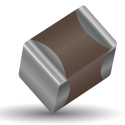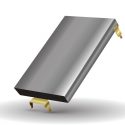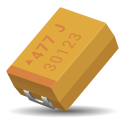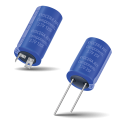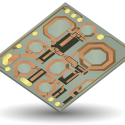A Review of High Frequency Passive Component Technologies (Thin-Film, Thick-Film, Discretes & PMC) for RF Design Applications Written By: Chris Reynolds Abstract: This article traces the evolution of these technologies and discusses the benefits and trade offs for each. The current level of RF component integration available in existing discrete package sizes is discussed, along with trends to tighter tolerance and ultra-stable parametric performance. The article concludes with an update on the emergence of higher levels of integration into passive component networks, and how this is now enabling engineers to optimize their RF designs. A version of this article was published in RF Design, August 2005.
News / Events / Press
Inductance Measurements for Multi-Terminal Devices Written By: Ben Smith Abstract: New innovations in both the telecommunication industry as well as the computer industry have mandated a need for using low inductance capacitive devices in power supply decoupling applications. With this being the case, different concepts for the construction of these devices have recently been the key to the success of reaching inductances of less than 50pH. There is, however, a significant bottleneck to the new innovation process due to measurement techniques. Most of the newer devices are using techniques such as multi-path current flow, short length, and equal and opposite current injection techniques to achieve low inductance levels. Also, coupled with these new designs is the need for higher energy
A Performance Comparison of Thin-Film and Wirewound Inductors Written By: Rom Demcko Abstract: This article evaluates the performance differences of thin-film and wirewound inductors. It looks at the properties of both technologies and evaluates the benefits particularly in wireless applications. A version of this article was previously published in Wireless Design and Development, May 2006.
Improved Noise Suppression via Multilayer Ceramic Capacitors (MLCs) in Power-Entry Decoupling Written By: Arch Martin | R. Kenneth Keenan Abstract: A new decoupling technique is proposed for surface mounted designs that recommends using 0.1 µF MLCs as the circuit-level decoupling capacitors and 1.0 µF to 10 µF MLCs in place of the tantalum as the board-level power-entry capacitor. This combination of MLCs on each PCB coupled with a single system level tantalum or aluminum is probably an optimum arrangement; performance is enhanced, and cost is not increased.
Functional Testing of Decoupling Capacitors For Dynamic RAMs Written By: Arch Martin | Ward Parkinson Abstract: Comparative performance of various types of distributed decoupling capacitors both with and without bulk tantalum capacitors is shown under actual operating conditions in a 64K dynamic RAM memory board designed especially for high-frequency in-use testing. Multilayer ceramic capacitors are shown to be effective and economical even without using bulk tantalum capacitors for decoupling.
Decoupling: Basics Written By: Arch Martin Abstract: This paper discusses the characteristics of multilayer ceramic capacitors in decoupling applications and compares their performance with other types of decoupling capacitors. A special high-frequency test circuit is described and the results obtained using various types of capacitors are shown.
BestCap®: A New Dimension in “Fast” SuperCapacitors Written By: Scot Tripp | Dr. Arieh Meitav Abstract: Supercapacitors or electrochemical caps are rapidly recognized as an excellent compromise between electronic capacitors such as ceramic, tantalum and aluminum electrolytic devices and batteries. Generally, supercapacitors have energy densities several orders of magnitude higher than electronic capacitors (Table 1) and power densities significantly superior to batteries. There are, however, two negative characteristics associated with existing electrochemical capacitors, high ESR and capacitance loss when called upon to supply very short duration pulses at high current. This paper will demonstrate how the BestCap® successfully addresses both of these issues.
BestCap®: A New Generation of Pulse Double Layer Capacitors Written By: Bharat Rawal | Lee Shinaberger Abstract: BestCap®, a new generation of Double Layer Capacitors (DLCs) have been developed to deliver low ESR, high power pulses, or provide back-up power in some applications. These capacitors have values of 10 to 560 mF, voltage ratings of 3.5 to 12 volts and ESR values of 20 to 500 mW. This paper describes the electrical properties of the BestCap® and it’s endurance under different environmental conditions. Specific applications are shown for illustrative purposes.
AC Termination For Signal Busses Written By: Ben Smith Abstract: The predominant direction of modern electronic system design is towards higher speed and efficiency. This is not to say that efficiency was not an issue in previous designs, but as clock speeds increase, many elements that once were treated as ideal cannot be treated in this manner any longer. Digital system designers are faced with critical issues dealing with maintaining signal integrity while balancing numerous other inhibiting factors. Perhaps one of the more menacing non-ideal effects can be seen in signal transmission through bus lines. Gone are the days when a trace of metal could be treated as a loss less element. Today’s high speed busses require a thorough evaluation
BestCap®: A New Generation of Low Voltage, Low ESR, Pulse, Double Layer Capacitors Written By: Lee Shinaberger | Bharat Rawal | Chris Reynolds Abstract: Electrochemical double layer capacitors (EDLCs) produced for back up applications in the last twenty-five years had high Equivalent Series Resistance (ESR) and high loss of capacitance when used in pulse power applications. In addition, the voltages of these devices were limited to less than 5 volts. In 2000, AVX introduced the BestCap® line of capacitors to address these limitations to serve the high pulse power market. This paper will present capabilities and subsequent improvements to the BestCap® product line.
Lead-Free Soldering Effect On Tantalum Capacitors Written By: T. Zednicek | P. Vasina | Z. Sita | B. Vrana Abstract: Legislation is being developed worldwide to reduce the lead content in many consumer electronic products. This is being taken as an action to reduce environmental impact when such products are discarded. Despite the fact that lead containing solders in electronic assemblies account for only 0.49% of world lead consumption, the trend in legislation will likely be to require not only reduced lead content, but also its complete elimination in such products. There are three principal sources of lead in electronic circuit assemblies; the solderable traces on the circuit card, the solderable finish on the components themselves and the solder alloy
Enhancing Cellphone Battery Performance During GSM Pulses Through the Use of a Parallel SuperCapacitor Written By: Ron Demcko | Patrick German Abstract: With the constant addition of features and functionality, battery life and reliability are becoming increasingly vital to those who rely on their smartphones. The transmission signal requires quick pulses of current from the battery, potentially causing the instantaneous voltage of the battery to drop below the phone’s minimum voltage of operation. This may cause the power to the battery to be temporarily interrupted. A series of tests were performed on multiple battery chemistries to determine the beneficial effect of placing an AVX supercapacitor in parallel with the battery, to improve the life of the battery as well as
Ceramic Multilayer Capacitors in HF SMPS Applications Written By: John Prymak Abstract: There has been an explosion of interest in the use of ceramic capacitors for high frequency power conversion applications. This interest is compounded with new designs striving for higher frequencies, smaller sizes and greater efficiencies. This application is an ongoing and mutual development of ceramic values, processes and sizes that were never realized prior to this application. In more and more cases, the ceramic capacitor is dictated by performance requirements never attainable in the previous styles of electrolytic and tantalum.
Output Filter Capacitors for Mission Critical Applications Written By: Pat Hollenbeck Abstract: The constancy and regularity of output voltage in a DC/DC output network is critical in SMPS (switched-mode power supplies) electronic performance. When different input and output voltages are required in the circuitry, output filter capacitors are required to maintain current uniformity and reduce noise. This document discusses the effect of capacitors on output power quality. It evaluates and provides a comparison of different capacitor technologies, their high reliability qualification availability from COTS+ to space level, and their impact on the output filtering capabilities in switching power supplies primarily used for mission critical applications.
Thin Film Filter Design and Technology Written By: George Korony Abstract: When specifying filter for a design, the admissible insertion loss and frequency range in the pass-band, the required attenuation and frequency ranges in the forbidden-bands, are the most important characteristics of filters. Several other important parameters are also required to define a filter, including functional parameters as input output impedances, power handling capabilities, and reliability requirements, as well as physical requirements such as dimensions, input-output type (wire-bond, SMT, BGA), and encapsulation. Other conditions may be imposed by special applications (space, automotive, medical)

